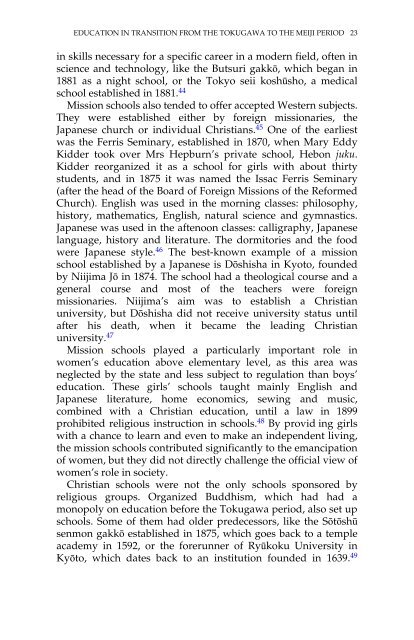Private Academies of Chinese Learning in Meiji Japan: The Decline ...
Private Academies of Chinese Learning in Meiji Japan: The Decline ...
Private Academies of Chinese Learning in Meiji Japan: The Decline ...
Create successful ePaper yourself
Turn your PDF publications into a flip-book with our unique Google optimized e-Paper software.
EDUCATION IN TRANSITION FROM THE TOKUGAWA TO THE MEIJI PERIOD 23<strong>in</strong> skills necessary for a specific career <strong>in</strong> a modern field, <strong>of</strong>ten <strong>in</strong>science and technology, like the Butsuri gakkō, which began <strong>in</strong>1881 as a night school, or the Tokyo seii koshūsho, a medicalschool established <strong>in</strong> 1881. 44Mission schools also tended to <strong>of</strong>fer accepted Western subjects.<strong>The</strong>y were established either by foreign missionaries, the<strong>Japan</strong>ese church or <strong>in</strong>dividual Christians. 45 One <strong>of</strong> the earliestwas the Ferris Sem<strong>in</strong>ary, established <strong>in</strong> 1870, when Mary EddyKidder took over Mrs Hepburn’s private school, Hebon juku.Kidder reorganized it as a school for girls with about thirtystudents, and <strong>in</strong> 1875 it was named the Issac Ferris Sem<strong>in</strong>ary(after the head <strong>of</strong> the Board <strong>of</strong> Foreign Missions <strong>of</strong> the ReformedChurch). English was used <strong>in</strong> the morn<strong>in</strong>g classes: philosophy,history, mathematics, English, natural science and gymnastics.<strong>Japan</strong>ese was used <strong>in</strong> the aftenoon classes: calligraphy, <strong>Japan</strong>eselanguage, history and literature. <strong>The</strong> dormitories and the foodwere <strong>Japan</strong>ese style. 46 <strong>The</strong> best-known example <strong>of</strong> a missionschool established by a <strong>Japan</strong>ese is Dōshisha <strong>in</strong> Kyoto, foundedby Niijima Jō <strong>in</strong> 1874. <strong>The</strong> school had a theological course and ageneral course and most <strong>of</strong> the teachers were foreignmissionaries. Niijima’s aim was to establish a Christianuniversity, but Dōshisha did not receive university status untilafter his death, when it became the lead<strong>in</strong>g Christianuniversity. 47Mission schools played a particularly important role <strong>in</strong>women’s education above elementary level, as this area wasneglected by the state and less subject to regulation than boys’education. <strong>The</strong>se girls’ schools taught ma<strong>in</strong>ly English and<strong>Japan</strong>ese literature, home economics, sew<strong>in</strong>g and music,comb<strong>in</strong>ed with a Christian education, until a law <strong>in</strong> 1899prohibited religious <strong>in</strong>struction <strong>in</strong> schools. 48 By provid <strong>in</strong>g girlswith a chance to learn and even to make an <strong>in</strong>dependent liv<strong>in</strong>g,the mission schools contributed significantly to the emancipation<strong>of</strong> women, but they did not directly challenge the <strong>of</strong>ficial view <strong>of</strong>women’s role <strong>in</strong> society.Christian schools were not the only schools sponsored byreligious groups. Organized Buddhism, which had had amonopoly on education before the Tokugawa period, also set upschools. Some <strong>of</strong> them had older predecessors, like the Sōtōshūsenmon gakkō established <strong>in</strong> 1875, which goes back to a templeacademy <strong>in</strong> 1592, or the forerunner <strong>of</strong> Ryūkoku University <strong>in</strong>Kyōto, which dates back to an <strong>in</strong>stitution founded <strong>in</strong> 1639. 49













